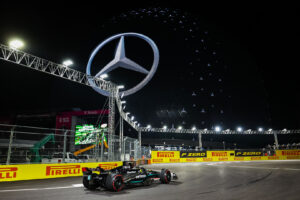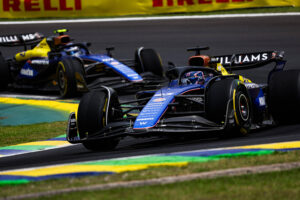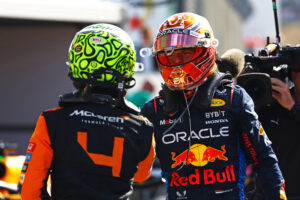From complete domination to intense battles between past and present teammates, let’s look at Williams’ top 5 seasons in F1 history.
Williams Grand Prix Engineering is one of the most iconic and successful teams in the history of Formula 1, boasting an illustrious legacy spanning several decades. Throughout the team’s storied history, there have been standout seasons that have defined their dominance in the sport. From groundbreaking technical innovations to legendary driver performances, Williams has left an indelible mark on Formula 1.
Williams have a total of 119 race wins, 313 podiums and 128 pole positions. They also have 9 Constructors’ Championships, 7 Drivers’ Championships. In this article, we delve into Williams’ top five seasons in F1 history.
5. 1993 – The Prost comeback
In the 1993 Formula 1 season, Williams had a dominant campaign with the FW15C chassis, powered by Renault engines. The car proved to be exceptionally competitive, offering both speed and reliability, allowing Williams drivers to consistently challenge for race victories.
Williams had a strong lineup with two talented drivers. Alain Prost the then three-time World Champion returned to Formula 1 after a year-long sabbatical and joined Williams for the 1993 season. Prost’s experience, skill, and consistency were key in leading the team’s charge for both the Drivers’ and Constructors’ Championships. Damon Hill made his F1 debut by joining Williams for the 1993 season. In that season, he showcased his potential as a top-tier driver. He quickly adapted to the competitive environment and proved to be a valuable asset to the team, contributing significantly to their success.
One of the standout highlights for Williams that season was Alain Prost securing his fourth Drivers’ Championship title. Prost’s return to the sport after a sabbatical was met with scepticism by some, but he quickly silenced doubters by consistently delivering exceptional performances throughout the season. Another significant highlight was Damon Hill’s impressive debut season with Williams. His three race victories and strong performances throughout the season showcased his talent and potential as a future champion.
Alain Prost won the Drivers’ Championship for the fourth and final team in his career with 99 points. In P2 was Ayrton Senna for McLaren with 73 points. Damon Hill impressively finished his debut season P3 in the standings with 69 points.
By the end of the season, Williams had a total of 10 race wins out of the 16, highlighting their dominance. Prost secured 7 wins, while Damon Hill contributed 3 wins to the team’s tally. As for the Constructors’ Championship, they won the title comfortably with 168 points which was a record-breaking achievement.
4. 1987 – Mansell v Piquet
The 1987 Formula One season gave us two teammates fighting for the title, between the Williams drivers – Nigel Mansell and Nelson Piquet. The F11WB was quite that package, allowing Williams to be particularly dominant.
Mansell and Piquet were a strong duo, however Mansell was faster. Throughout that season, Mansell had a total of 8 poles, whilst Piquet had 4. Mansell also had the majority of race wins, with 6 wins whilst Piquet had 3. Needless to say, Piquet was always close behind his British teammate. Seven P2 finishes kept the Brazilian in the hunt for the title.
In the Drivers’ Championship, Nelson Piquet was crowned champion with 73 points, whilst Nigel Mansell, finished with 61 points in second place.
Nelson Piquet winning the 1987 Formula 1 Drivers’ Championship despite Nigel Mansell’s superior performance in qualifying and races was due to a number of reasons. While Mansell often showed exceptional pace and secured more pole positions and race wins, Piquet demonstrated greater consistency throughout the season. Piquet frequently finished races in the points, consistently accumulating valuable championship points even when he didn’t win. Piquet finished outside of the podium only twice, finishing P4 and P15 on those occasions. Mansell on the other hand finished outside of the podium thrice, in P5, P6 and P14.
Mansell also encountered several reliability issues and retirements throughout the season. Piquet, on the other hand, experienced relatively fewer mechanical failures, allowing him to consistently score points and stay in contention for the title.
At the Belgium Grand Prix, Mansell retired due to a collision with his teammate Nelson Piquet. Piquet also retired. In Monaco Mansell retired due to a gearbox failure. At the German GP Mansell retired due to another collision, this time with Ayrton Senna. The Portuguese Grand Prix saw Mansell retire due to a suspension failure.
Another moment that cost Mansell the WDC was at the Japanese GP. He had acquired pole but was not able to start the race due to a problem with the engine on his Williams Honda during the warm-up session before the race.
In the Constructors’ Championship, Williams secured the title with 137 points, followed by McLaren-TAG with 76 points and Lotus-Honda with 64 points. Williams had won 9 of the 16 races that season.
3. 1986 – Down to the wire
The 1986 Formula 1 season marked a significant milestone for Williams. Williams fielded the FW11 chassis, powered by Honda engines. The FW11 proved to be highly competitive, offering both speed and reliability, allowing Williams drivers to challenge for race victories throughout the season.
Nigel Mansell played a crucial role in Williams’ campaign. He emerged as a serious championship contender, challenging for race wins and podium finishes. Nelson Piquet the then two-time World Champion joined Williams for the 1986 season and brought with him a wealth of experience and technical expertise.
The 1986 Formula 1 season featured an intense battle for the Drivers’ Championship title, with Alain Prost, Nigel Mansell, and Nelson Piquet locked in a tight competition throughout the season. The battle for the title intensified with each race, as Prost, Mansell, and Piquet traded victories and podium finishes. The championship lead changed hands multiple times throughout the season, keeping fans on the edge of their seats until the very end.
Despite their competitiveness, Williams faced reliability issues with their cars throughout the season. Mechanical failures and retirements for both Mansell and Piquet hampered their championship bids, adding an extra layer of drama to the title fight.
This was one of the closest championship battles in F1 history. Heading to the final race of the season, Mansell had 70 points, 6 more than Prost and 7 more than Piquet. With the Williams being dominant, it was expected that it wouldn’t be Prost that would win the title.
Mansell was on course for the title when his left rear tyre exploded at 180 mph. Williams had no choice but to call Piquet to the pits and so Prost went into the lead. Prost went on to win the race and the World Championship after an exhilarating race. Alain Prost had clinched the Drivers’ Championship title by a narrow margin of just 2 points, with Mansell finishing a close second and Piquet 1 point behind his teammate.
Despite losing out on the Drivers’ Championship, Williams had a successful campaign in the Constructors’ Championship. That season they won their third Constructors’ Championship title with a total of 9 race wins out of the 16. Nigel Mansell secured 5 wins, while Nelson Piquet contributed 4 wins to the team’s tally.
2. 1996 – Damon Hill’s glory run
In the 1996 Formula 1 season, Williams had a strong campaign. The Williams FW18 proved to be one of the most competitive cars on the grid, offering both speed and reliability.
Damon Hill, the son of former World Champion Graham Hill, led Williams’ charge in the 1996 season. Jacques Villeneuve made his F1 debut with Williams. Villeneuve quickly established himself as a rising star in the sport.
Not only was the Williams quite dominant, but they also demonstrated remarkable consistency throughout the season. Both drivers regularly finished in the points-scoring positions. The only time they had a finish outside of the points was in Italy when Villeneuve crossed the line P7.
Although, there were a few bumps on the road for the team. In Monaco, it was a double DNF for them. Hill retired following a failed oil pump that caused his engine to blow. Meanwhile, a collision with Luca Badoer led to Villeneuve retiring. A few driver errors and wheel bearing issues led to a few other retirements across the season for Williams.
Williams had a successful campaign in the Constructors’ Championship, clinching their 9th Constructors’ Championship title. Their consistent performance throughout the season, coupled with numerous race victories and podium finishes, solidified their position as one of the top teams in Formula 1.
Williams won a total of 12 race victories out of the 16 that season. Damon Hill secured 8 wins, while Jacques Villeneuve managed 4 wins. That secured P1 and P2 with 97 and 78 points for Hill and Villeneuve respectively in the Drivers’ Championship. It was Damon Hill’s first and only World Drivers’ Championship in F1.
1. 1992 – Pure dominance
In the 1992 Formula 1 season, the Williams FW14B proved to be one of the most technologically advanced and dominant cars in Formula 1 history. Designed by Adrian Newey, the FW14B gave Williams a significant performance advantage over their rivals. On the wheel were Nigel Mansell and Riccardo Patrese.
Williams had a dominant campaign in the Constructors’ Championship, clinching their 5th Constructors’ Championship title with ease. The FW14B’s superiority resulted in a record-breaking season for the team. Williams amassed a total of 10 race victories out of 16. Nigel Mansell had an incredible 9 wins, while Riccardo Patrese contributed 1 win to the team’s tally.
Nigel Mansell’s performances in the 1992 season were nothing short of spectacular. He showcased his blistering pace and unmatched determination, breaking multiple records and dominating races from start to finish. Records he set in 1992 that he still holds are the highest percentage of pole positions in a season (88%) and most runner-up championship finishes before becoming World Champion (three).
Mansell had a total of 14 pole positions and 9 wins in a 16-race season, earning him a total of 108 points and the Drivers’ Championship title. The British driver also never finished a race outside of the podium. While Mansell received much of the spotlight, Riccardo Patrese’s contributions to Williams’ success should not be overlooked. Patrese’s consistent performances and podium finishes provided valuable support to Mansell and played a crucial role in securing the Constructors’ Championship title. Notably, Patrese finished outside of the podium only twice all season.
The 1992 season is remembered as one of the most dominant seasons in F1 history, with Williams’ FW14B and Nigel Mansell’s performances setting new benchmarks for excellence in the sport. The success of the FW14B solidified Williams’ status as a powerhouse team in F1 and left a lasting legacy in the sport’s history.






